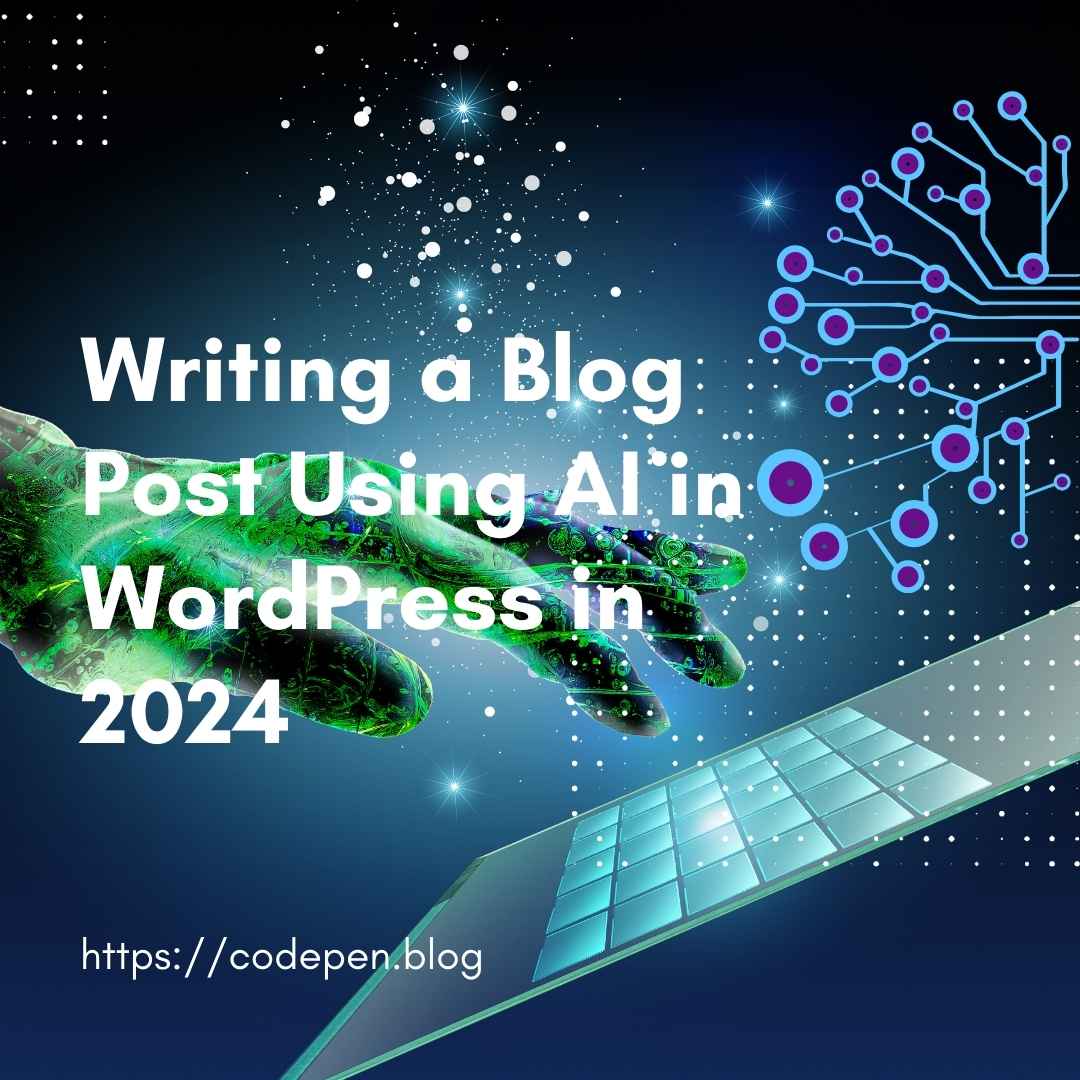Are you searching for the top AI for Composing a Blog Post With AI in WordPress? In this article, we provide you with the greatest AI tools for composing a blog post utilizing AI.
Keeping up a blog inside your WordPress website is essential for delivering valuable content to your audience. Additionally, well-crafted blog posts can enrich your site’s visibility on search engine results pages (SERPs). In the past, individuals lacking strong writing abilities had no option but to employ someone to craft their posts, or worse, abstain from having a blog totally.
Due to the emergence of artificial intelligence (AI) tools like ChatGPT and Divi AI, you now have the chance to utilize this cutting-edge technology to help in producing your posts.
What is WordPress?
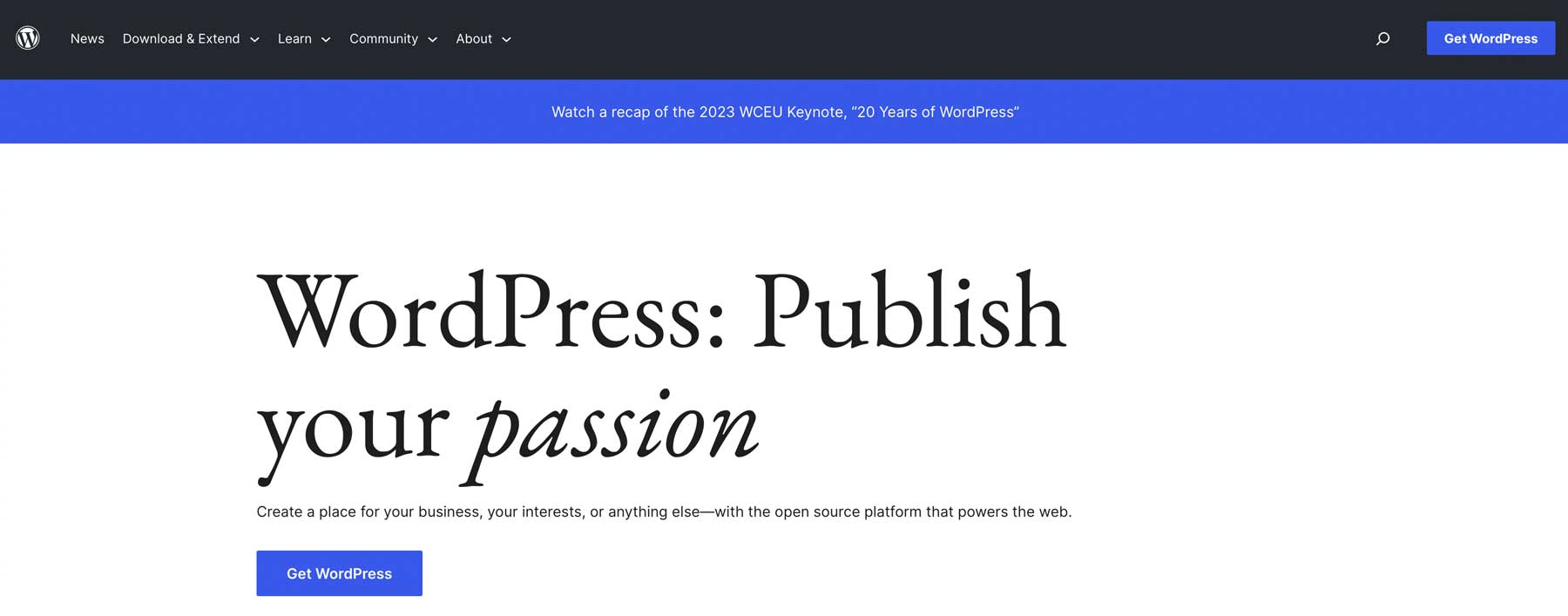
WordPress is a prevalent content management system (CMS) that is employed on over 43% of all websites on the internet. It originated as a blog platform in the late 90s and has advanced into a website-building powerhouse utilized by freelancers, web agencies, and huge corporations. There are two versions of WordPress. .org and .com. Although they are constructed by the same individuals, there are some distinctions. So, for clarity, we will be operating in WordPress.org, which is self-hosted and comes with almost limitless customization options.
What is AI?

image created with Divi AI | Prompt: photo of a Maine Coon cat, set a snowy forest, dramatic lighting, ultra quality, 8K UHD, Nationwide Geographic Wildlife photo of the year
AI is the advancement of computers that utilize machine learning to achieve tasks that would typically necessitate humans to do. AI can train these systems to produce images, text, video, music, and more. This kind of AI is termed generative AI, which entails extensive training between two systems, or generative adversarial networks (GANs), comprising a discriminator and a generator. They collaborate to compare the generator’s output to the data the system was trained on. For instance, during image generation, the generator presents output to the discriminator, which attempts to ascertain if it’s real or fake. As training progresses, the generator will excel at output, so the discriminator cannot differentiate between the two.
Some of the more favored AI text and image generators like Divi AI, Jasper, Writesonic, and ChatGPT have numerous uses, including composing blog posts, creating lifelike images, and more.
What is Divi AI?
Divi AI is the newest, most thrilling product release in recent memory. Based on Stable Diffusion and Open AI models, Divi AI can write content and produce images directly inside the Visual Builder. That being said, Divi AI is constructed slightly differently than other generative AI. Made specifically for Divi, it comprehends all of Divi’s design elements and can provide suggestions for text and images based on the associated content on the page. For example, if your page is about a Maine Coon cattery, Divi AI will recommend text related to Maine Coon cats. This remarkable new technology will make creating Divi websites simpler than ever!
How to Compose a WordPress Blog Post With AI
SUBSCRIBE TO OUR YOUTUBE CHANNEL
With all of the AI technology available to WordPress users today, there are various methods to compose a blog post utilizing AI. However, for this post, we will focus on two pathways. The first utilizes Divi AI, and the other uses ChatGPT and Midjourney.
Irrespective of the technique employed, using the Gutenberg editor to compose blog posts is recommended. The primary reason for this is thatcomplete site customization themes such as Divi or Twenty Twenty-Three permit you to generate templates to exhibit your site’s content. Details about Gutenberg won’t be covered here, but this article outlines how to navigate in the block editor. If you are already a Divi user, you’ll be pleased to know that we bolstered compatibility with the block editor in 2022 by introducing the Divi layout block. It enables the simultaneous use of the Gutenberg editor and Divi Builder, which will be essential for utilizing Divi AI.
Establishing a Format
Before drafting your initial post, you will need to understand how to construct a format using Gutenberg or Divi. Once your format is established, you can proceed with your work.
Phase 1: Developing the Blog Post Outline
We will delineate the measures for designing a blog outline using ChatGPT. While this phase is not mandatory, it will aid you in structuring your ideas and providing a framework for AI to follow. If you have not done so already, sign up for an account with ChatGPT. Version 3.5 is free, but a subscription to a paid plan is required for accessing the advanced version. For our post, we aim to highlight the dog-like characteristics of Maine Coon cats, so we will utilize the following prompt: Create a blog post outline explaining how Maine Coon cats resemble dogs.
ChatGPT will proceed to generate an outline for our post:
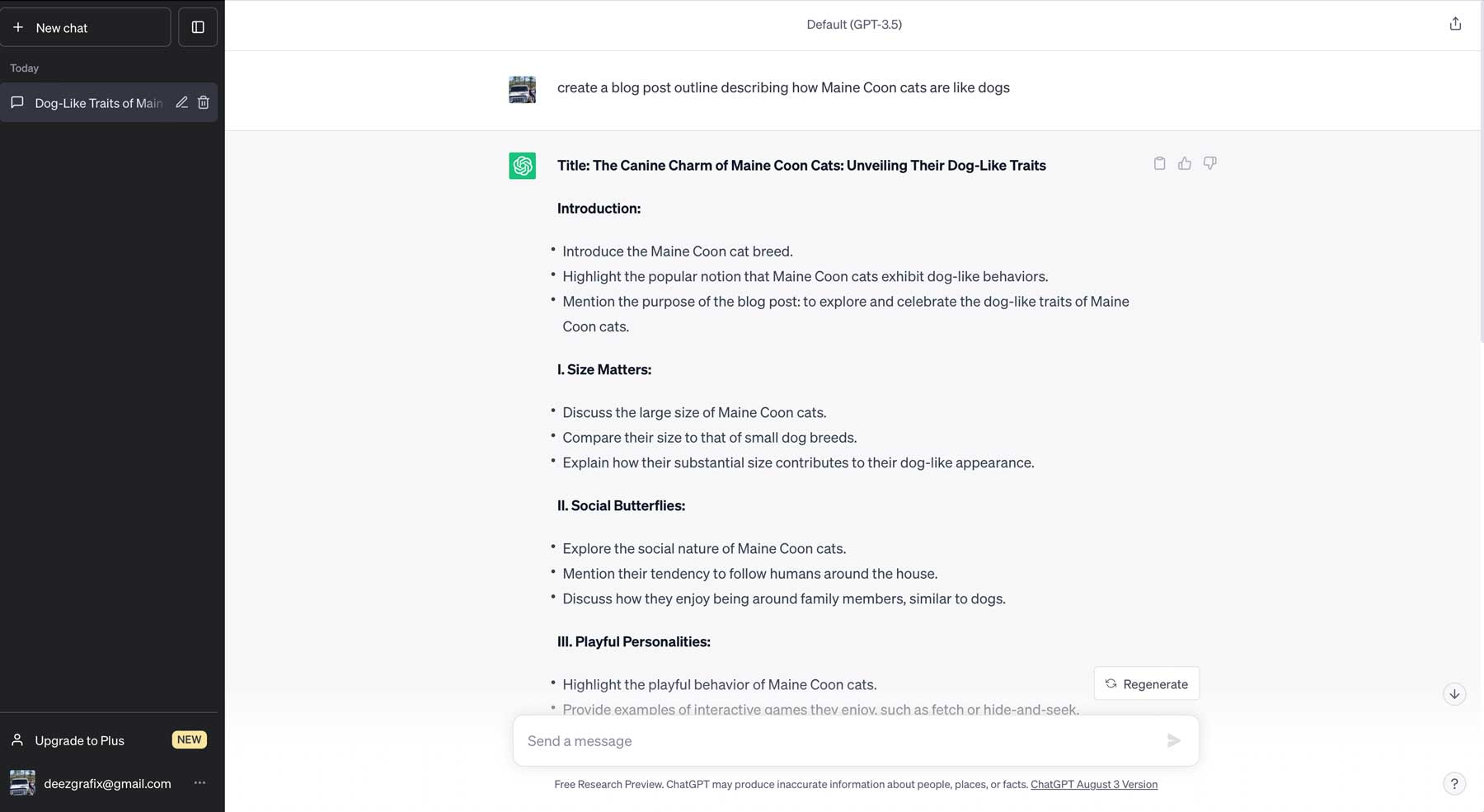
Phase 2: Formulating a New Post
To initiate a fresh post, sign into your WordPress dashboard, then navigate to posts (1). Subsequently, click the Add New button (2) to compose your first post.
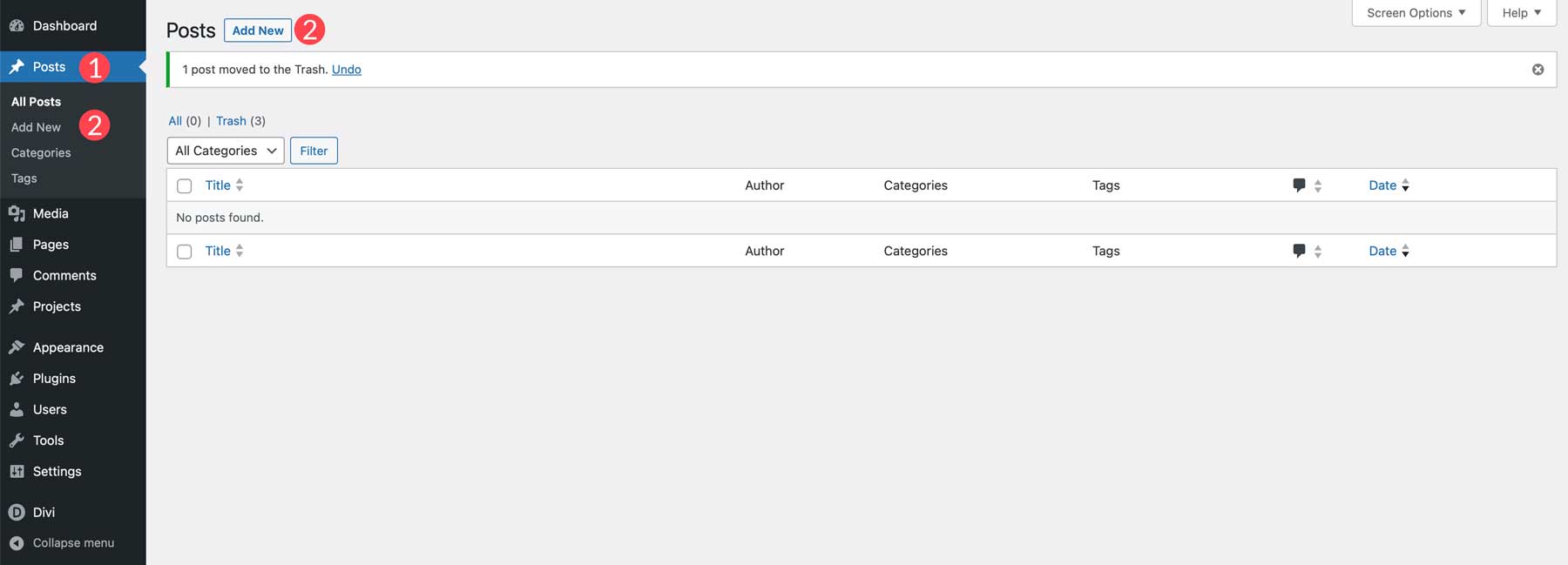
Proceeding, we will need to incorporate a title to our post (1). Let’s utilize the one generated with ChatGPT: The Canine Charm of Maine Coon Cats: Unveiling Their Dog-Like Traits.
If employing Divi, tap the default editor button (2) to load Gutenberg.
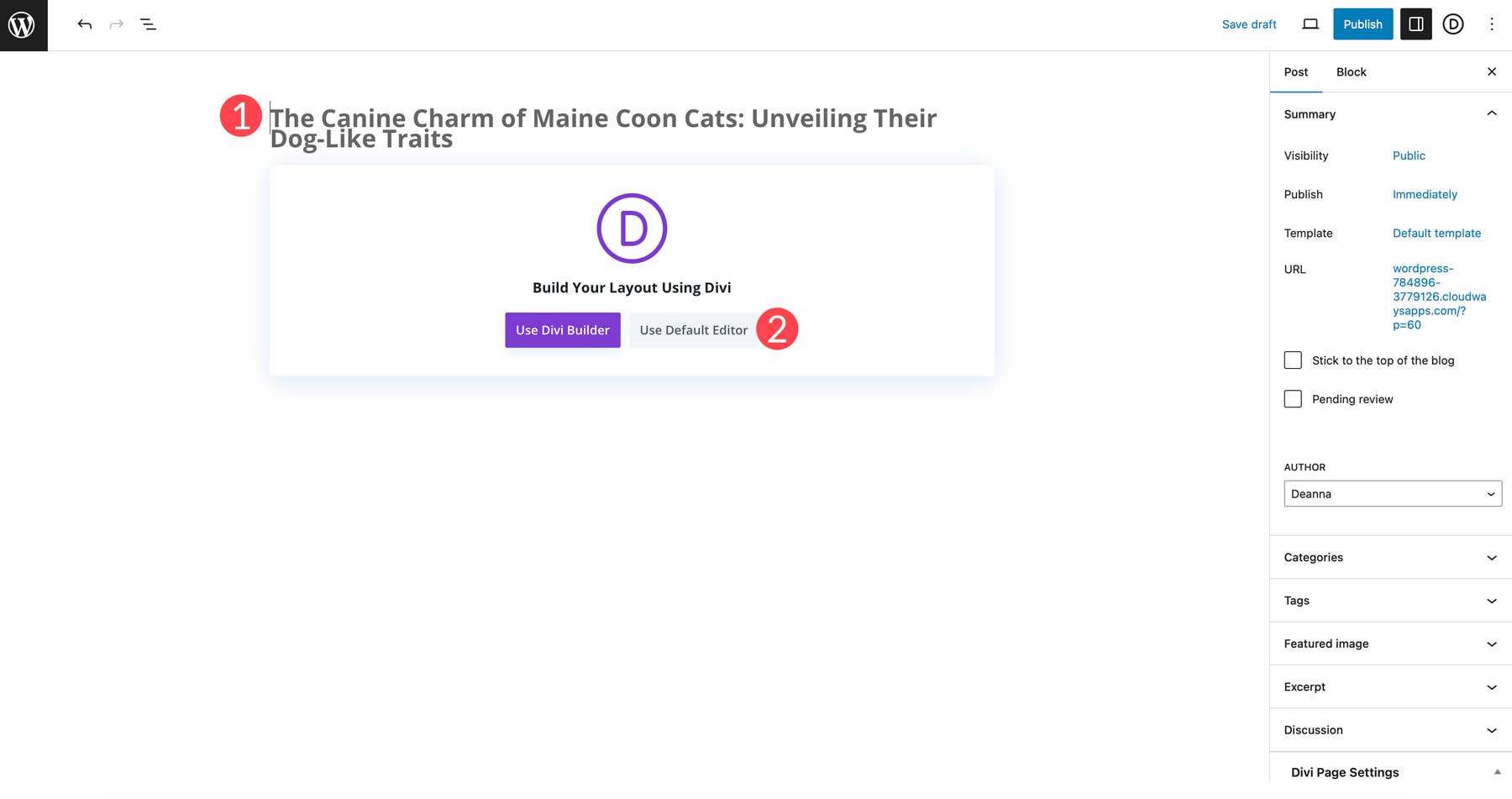
Phase 3: Drafting the Introduction
After composing the post, the primary step is to incorporate an introductory paragraph.
Utilizing ChatGPT
Producing an introduction paragraph is straightforward using ChatGPT. Return to the interface and formulate the prompt: Create an introduction paragraph using the previously defined outline. Maintain a concise content within 300 words, briefly touch upon the points in the outline, and impart a human-like tone of voice.
Now, you have two options. You can either replicate the generated paragraph or utilize it as a guide while crafting original content. To adhere to ethical considerations, we will modify the introduction paragraph by leveraging the generated output as a mere reference.
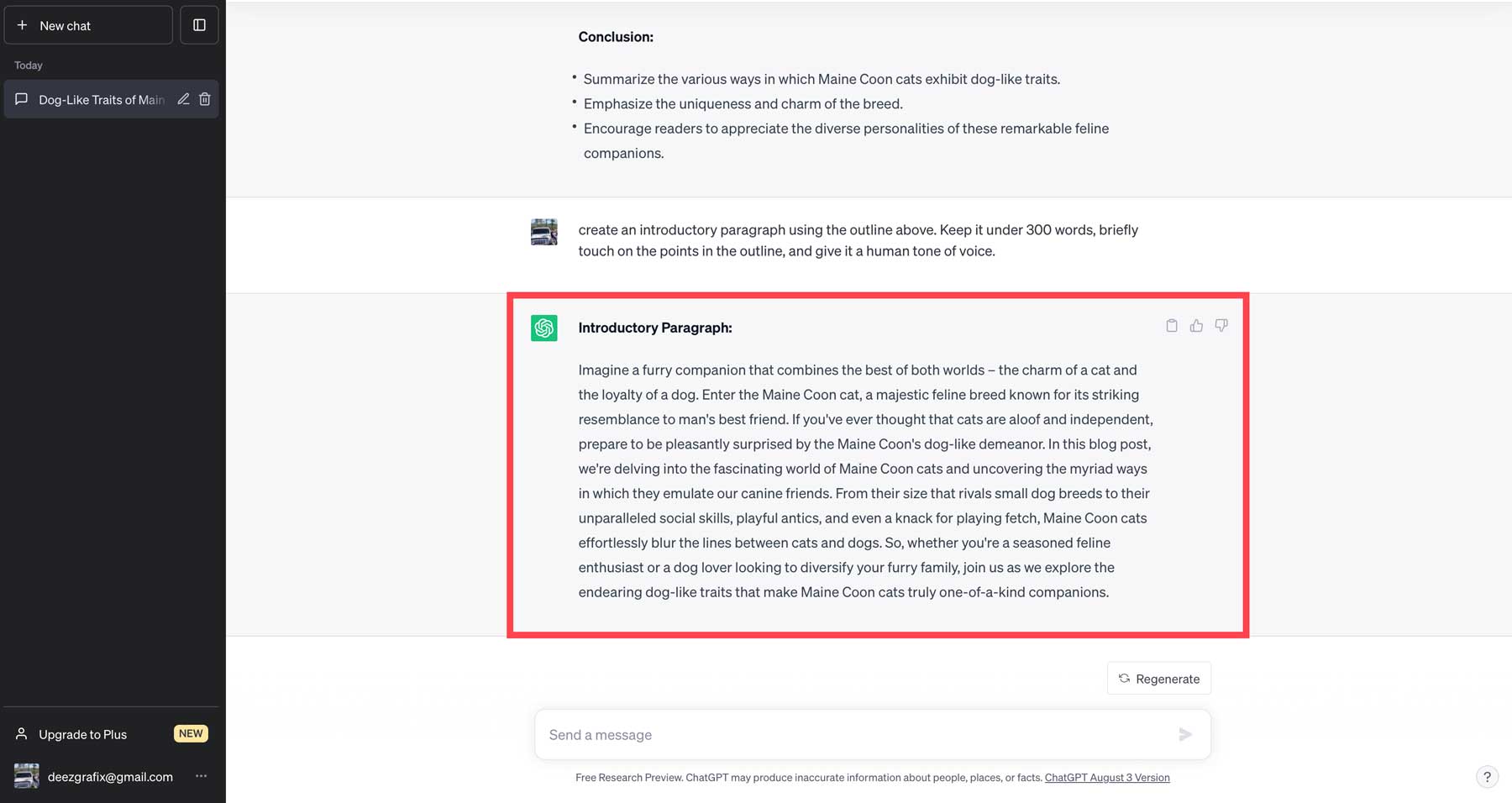
Add the output to the default editor by appending a paragraph block. To do this, click the + icon (1) in the page builder or proceed to the list view (2) to add a paragraph block there.
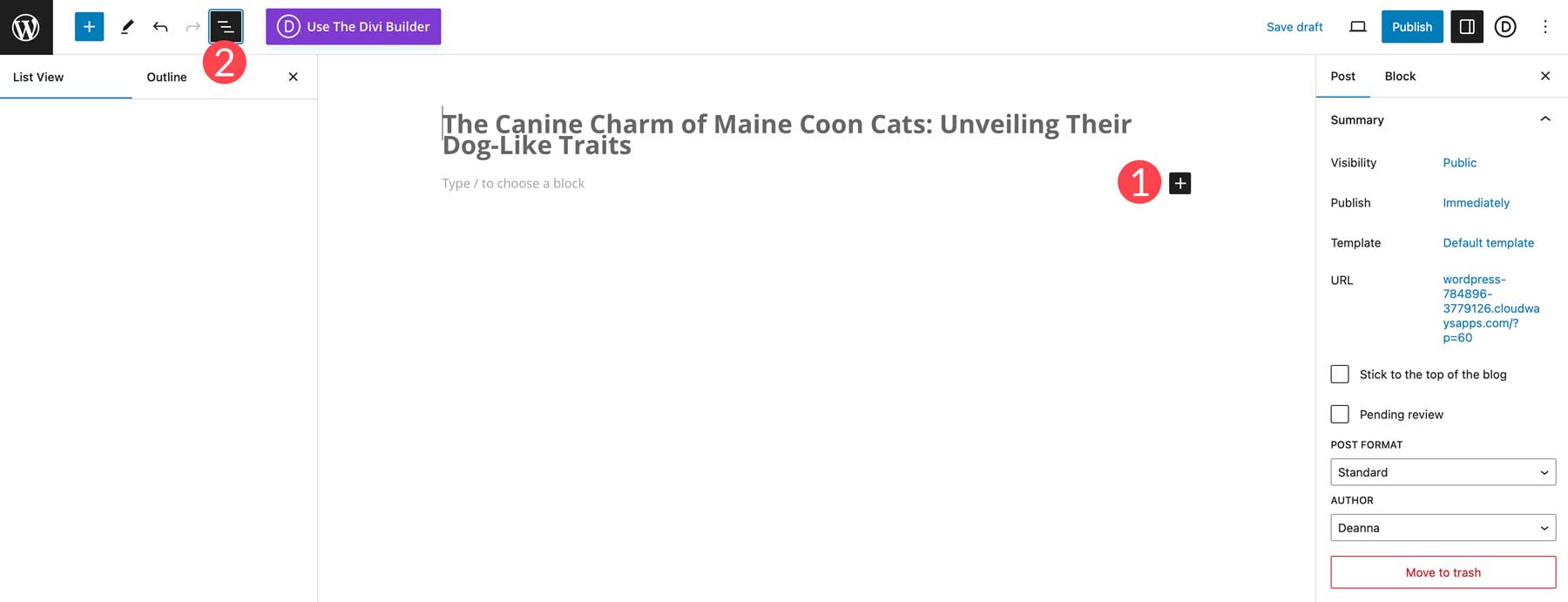
Using Divi Within Gutenberg
If using Divi, the setup needs to be done differently. Instead of adding a paragraph block to integrate content, we will utilize Divi for creating our post. The initial process is similar, except for the block. Click the + icon (1), then search and insert the Divi Layout block (2).
“`html 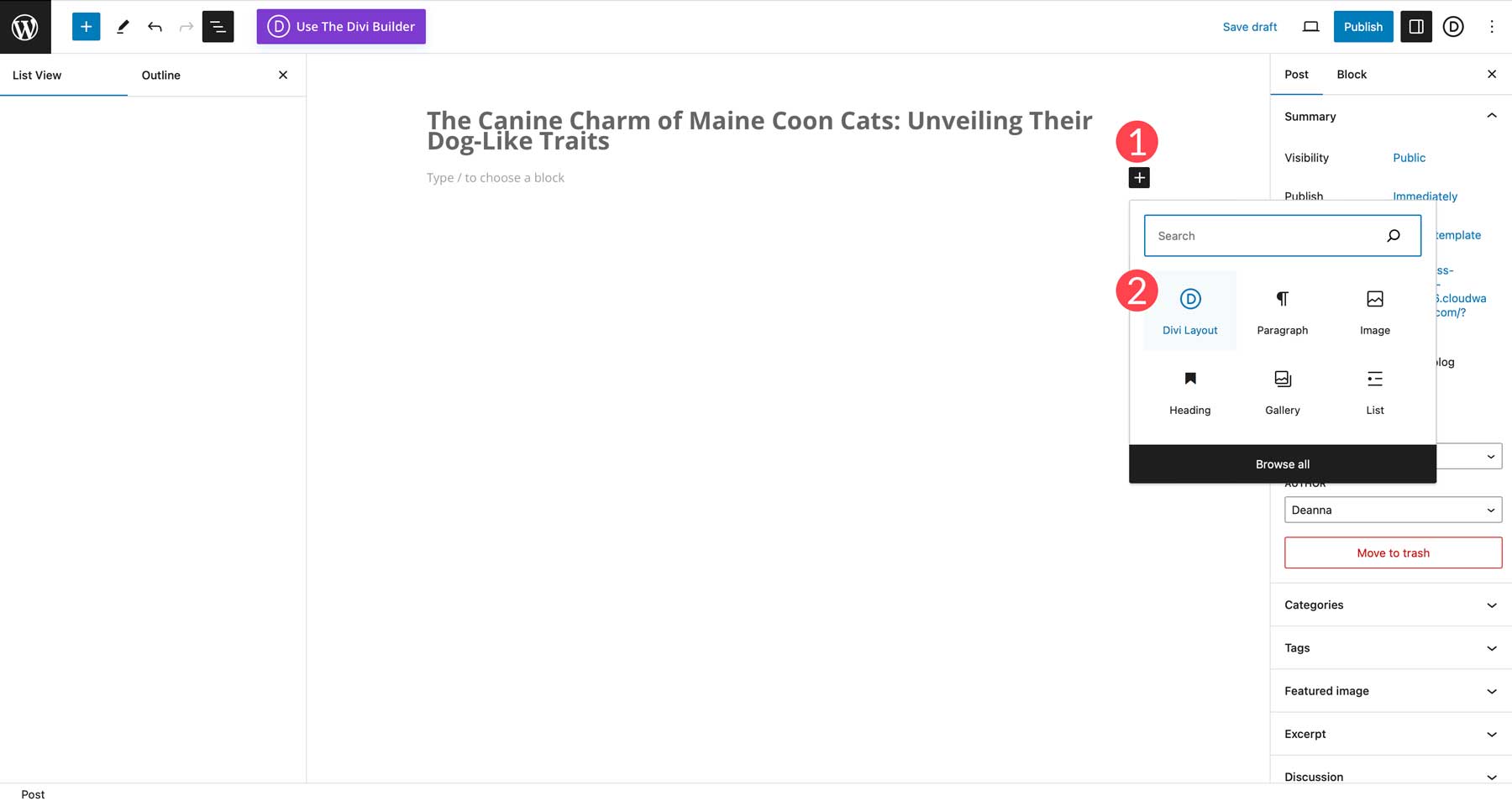
Then, press the Construct New Layout button.

To devise our latest layout, we will create it from the start. Click the Initiate Building button to proceed.

Select the single column row.
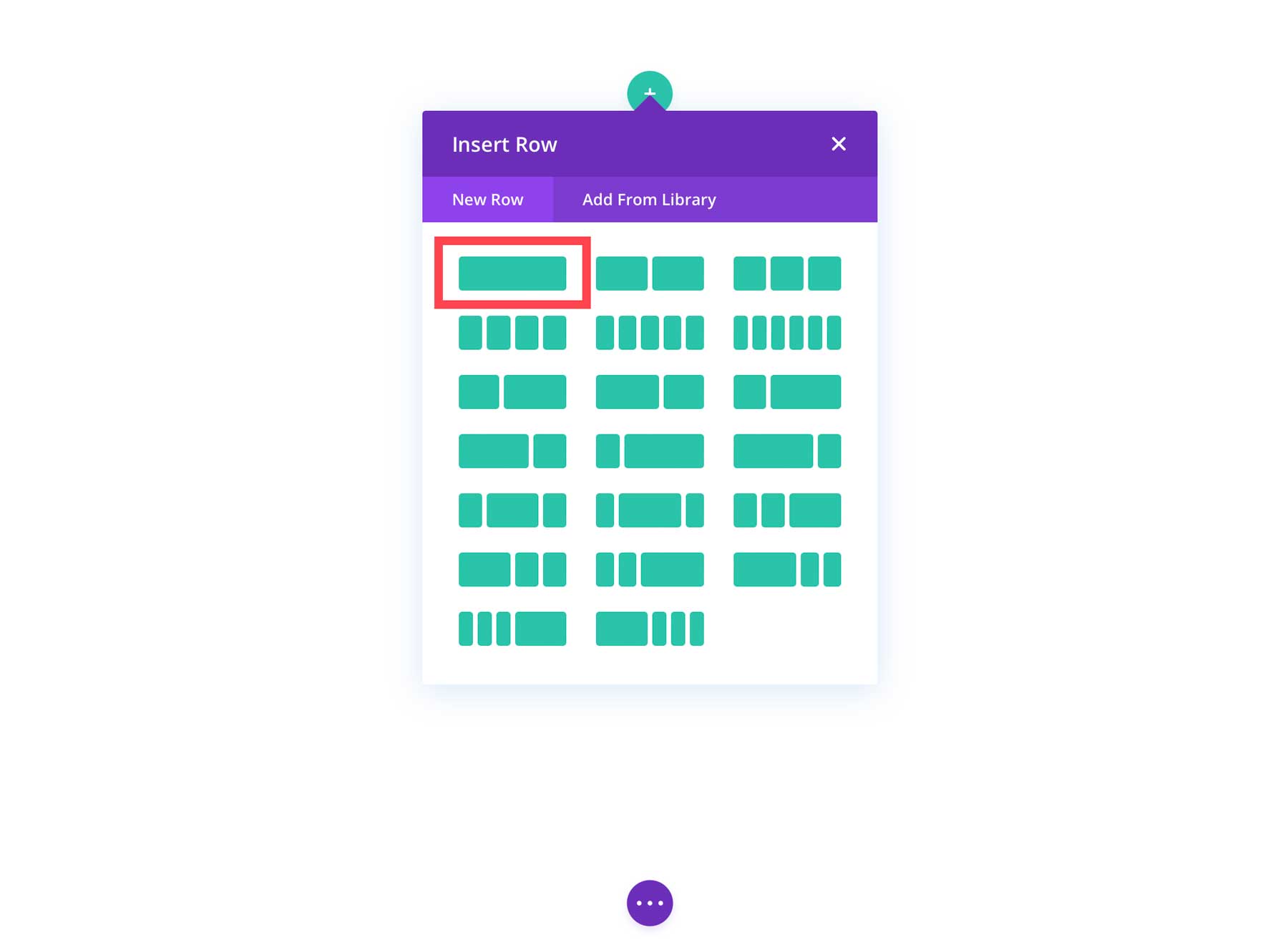
Pick a text module to establish AI-generated text.
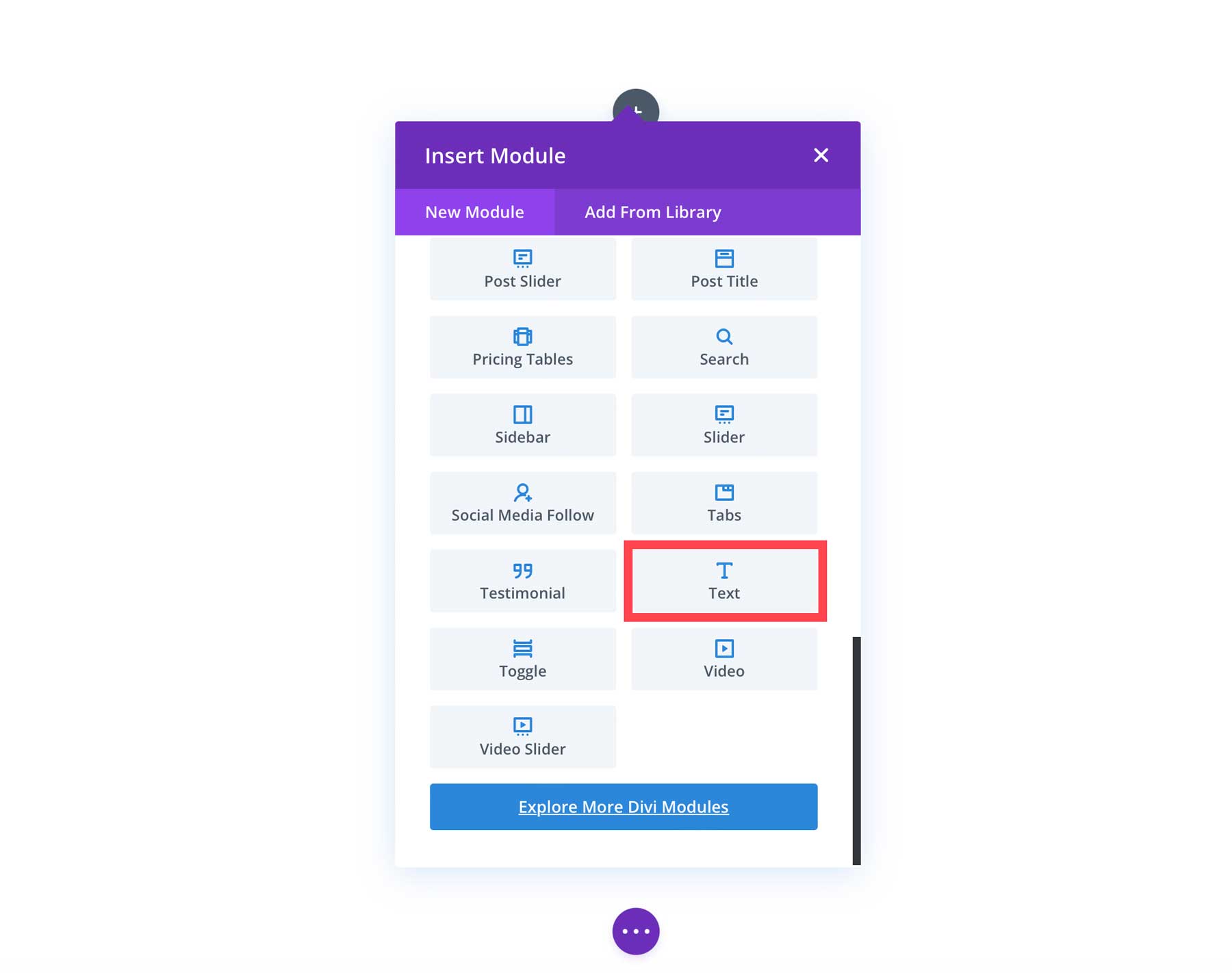
Introducing the Divi AI User Interface
Producing text with Divi AI is straightforward. Initially, press the Create Content with AI button (1) or hover over the placeholder text to expose the AI icon (2). You will have two choices: Compose with AI (3) or Write Automatically (4). Opting for the automatic alternative will create text automatically. This is a terrific feature for posts and pages with content you wish to elaborate on. For this scenario, however, we will decide to compose with AI. This will allow us to offer Divi some context.
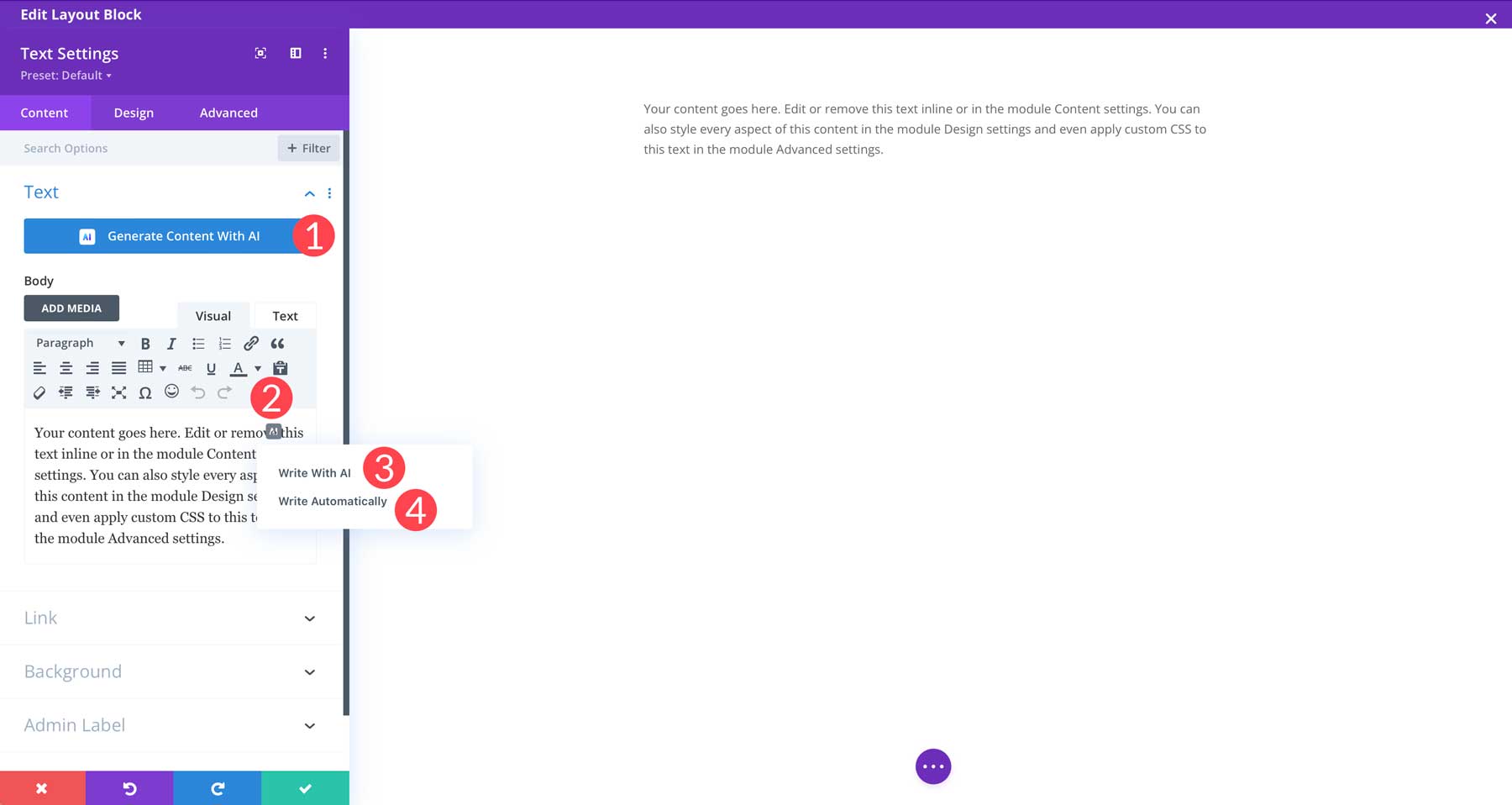
You will observe a new dialog box with several features when your screen updates. Let us briefly elucidate the function of each setting:
- Content Type: This enables you to form a paragraph, title, button, blog post, or social media post.
- What are you writing about: Employ this to provide Divi a starting point for your text.
- Added Context: If you have already commenced creating your post, you can utilize this to give Divi context. Choices include this page content, this section content, this module content, or no context.
- Tone of Voice: Select the writing style you prefer from the available options: creative, informative, and funny.
- Must use keywords: Incorporate essential keywords into your text.
- Content length: Specify the number of words, sentences, characters, paragraphs, or list items you require.
- Language: At this point, you can specify the language. You can either employ the language of your prompt or select from over 130 supported languages.
- Create Text: Elicit text with Divi AI.
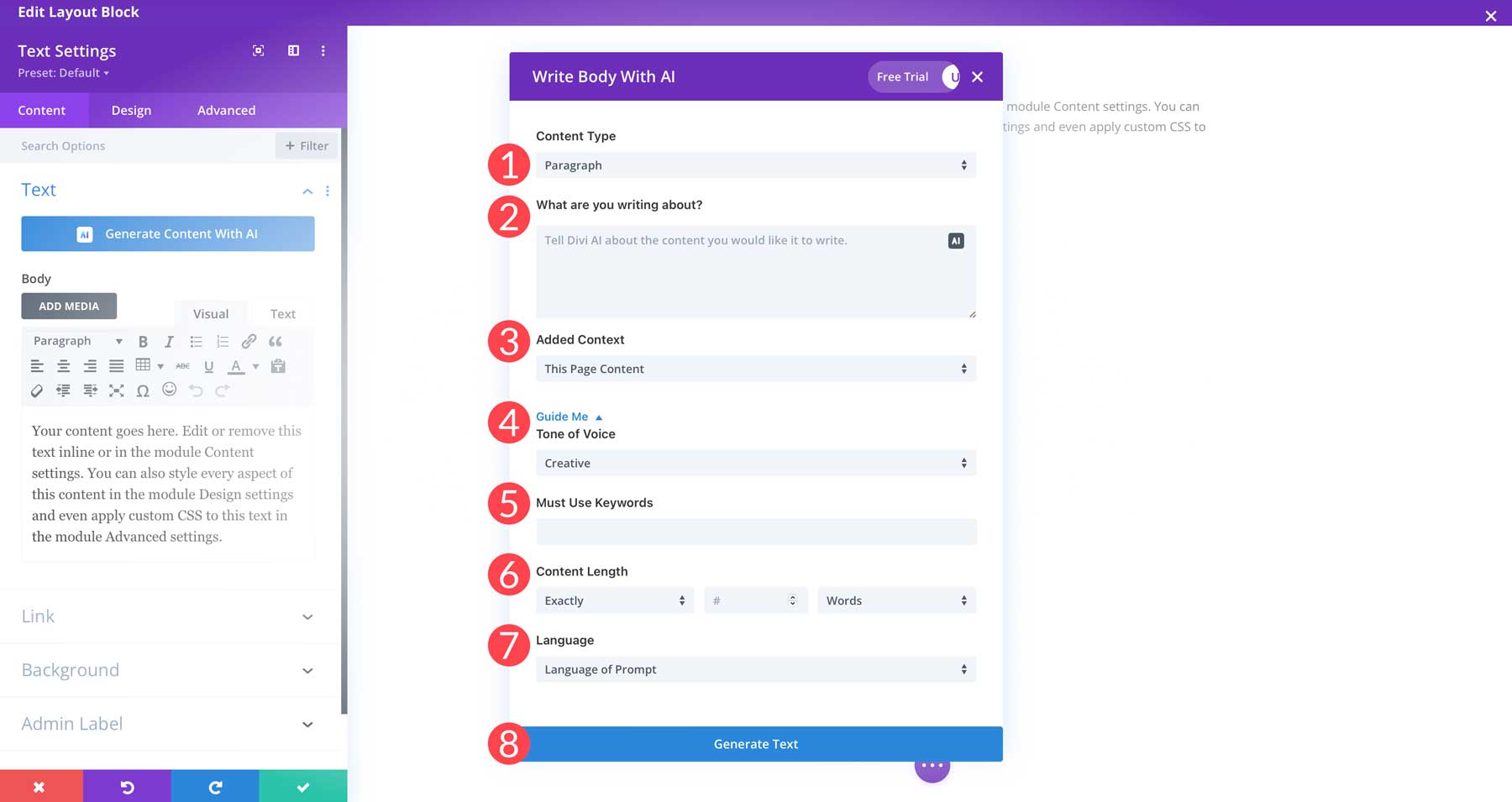
Producing Text with Divi AI
To generate our inaugural paragraph, we will select the following preferences:
- Content type: Paragraph
- What are you writing about: Compose an opening paragraph about how Maine Coon cats have dog-like qualities
- Added Context: No context
- Tone of Voice: Creative
- Must use keywords: Maine Coon, dog-like
- Content length: Exactly 200 words
- Language:“` Language of query
After enabling the configurations, press the create button to generate the text. Divi will produce the text based on your query. If you are content with the outcomes, click the Use this text button (1). Conversely, if you wish to adjust, you can revise the output by clicking retry (2) or by opting for the enhance with AI drop-down menu (3). You have the option to enhance, reword, extend, reduce, simplify, rephrase, or modify it by altering the tone of voice, among other choices. If you want to refine it, you can include more details in refine result (4) text field and then click regenerate (5).

Step 4: Crafting Blog Post Photos
The subsequent stage is to form an illustration for our post. In the end, blog posts are enhanced with accompanying pictures. They offer visual assistance, engage your readers, and function as a method to amplify your site’s search engine optimization (SEO) using alt tags.
We will exhibit two approaches to form illustrations for your WordPress blog post: Midjourney and Divi AI.
Utilizing Midjourney

picture created with Midjourney
Midjourney entered the market earlier this year and has emerged as one of the most prevalent platforms for generating pictures. We won’t delve into the steps to utilize it here, as we have an extensive tutorial already prepared for you. Midjourney creates some of the most astonishing AI art</a you’ll come across. Nevertheless, we should advise caution when using it commercially. Due to ongoing legal action, its future is uncertain. Nonetheless, creating pictures with it is likely acceptable if you are a paid subscriber. This article focuses on the second approach, Divi AI.
Using Divi AI
Another (and superior) approach to generate pictures for your blog posts is by employing Divi AI’s incorporated picture generation tool. It operates similar to the AI text generator, allowing you to craft, refine, and employ images within your posts or pages. Unlike other AI picture generators, there is no necessity to utilize a separate platform. With Divi AI, you acquire the capabilities of Stable Diffusion directly in the Visual Builder. To create an image using Divi AI, append an image module to your post.
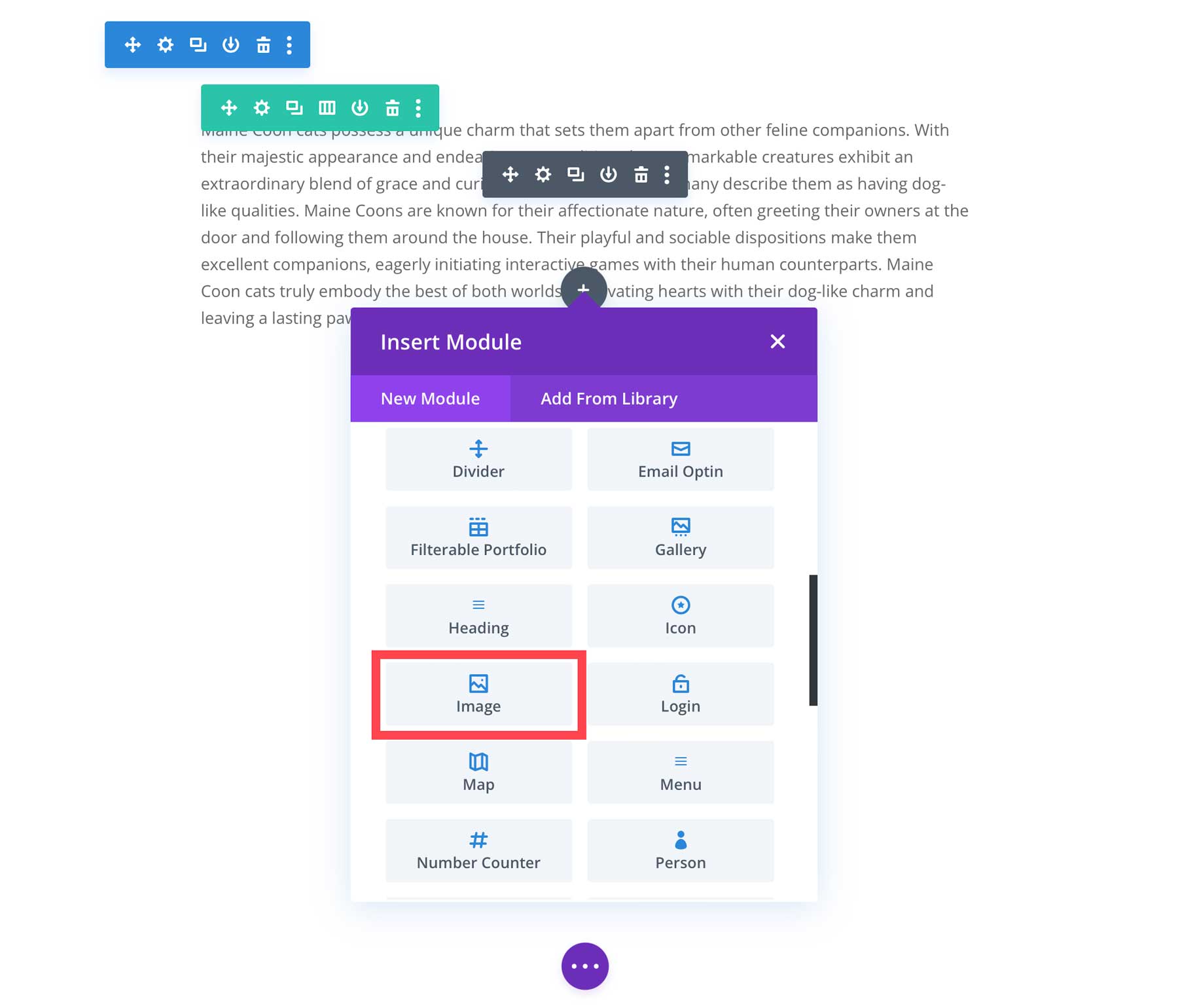
To activate AI, hover over the placeholder image in the module to reveal the AI icon.
![]()
Upon clicking the icon, you have two options: Generate with AI or Generate Automatically. Choose the first option.

Divi AI Image Configurations
Prior to generating an image, let’s review the settings so you comprehend the functioning. We won’t cover all the details related to generating images, such as prompting tips, but we will present the fundamentals.
- Image style: Select from 13 style presets, including photograph, digital artwork, vector illustration, and more.
- Image description: The text prompt field utilized to describe your desired image.
- Reference image: If you have a specific image in mind that isn’t quite what you need, you can use it as a reference image to aid Divi AI in creating the perfect one.
- Aspect ratio: You can opt for square (1:1), Landscape (8:5), portrait (3:4), or a custom size.
- Size: The pixels (width x height) for your image.
- Generate: Generatesan image founded on the settings above.
Analyze an Image Using Divi AI
After understanding the interface, let’s produce our initial image. Given that our blog article is regarding Maine Coon cats, we will generate an image that can be utilized in our write-up, which we can also apply as our prominent image. When the AI image dialog box appears, enter the subsequent settings:
- Image type: Photograph
- Image description: photo of a brown sortie Maine Coon cat, resting on a couch, watching outside the window, award-winning photography, soft shadows, midday lighting, cinematic photography
- Reference image: none
- Aspect ratio: Landscape (8:5)
- Size: 1280 x 800
With the settings configured, select the generate button to produce your photo.
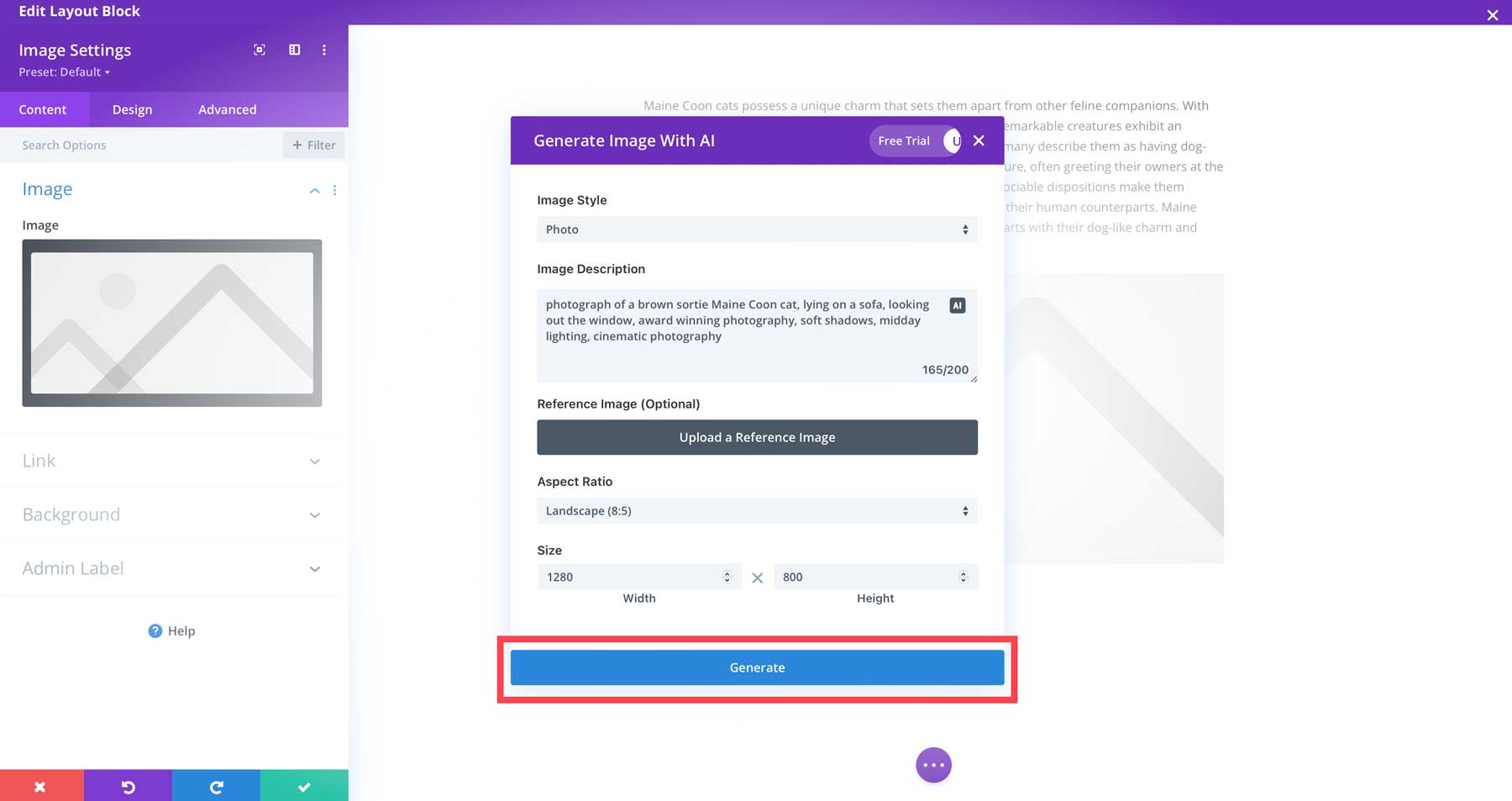
Following completion of the process, Divi will supply four images. To pick one, choose your preferred one (1) and then click Use this image (2). Otherwise, you can produce more similar images (3), generate four more (4), modify the style (5), or add an entirely new description (6) to regenerate it (7).
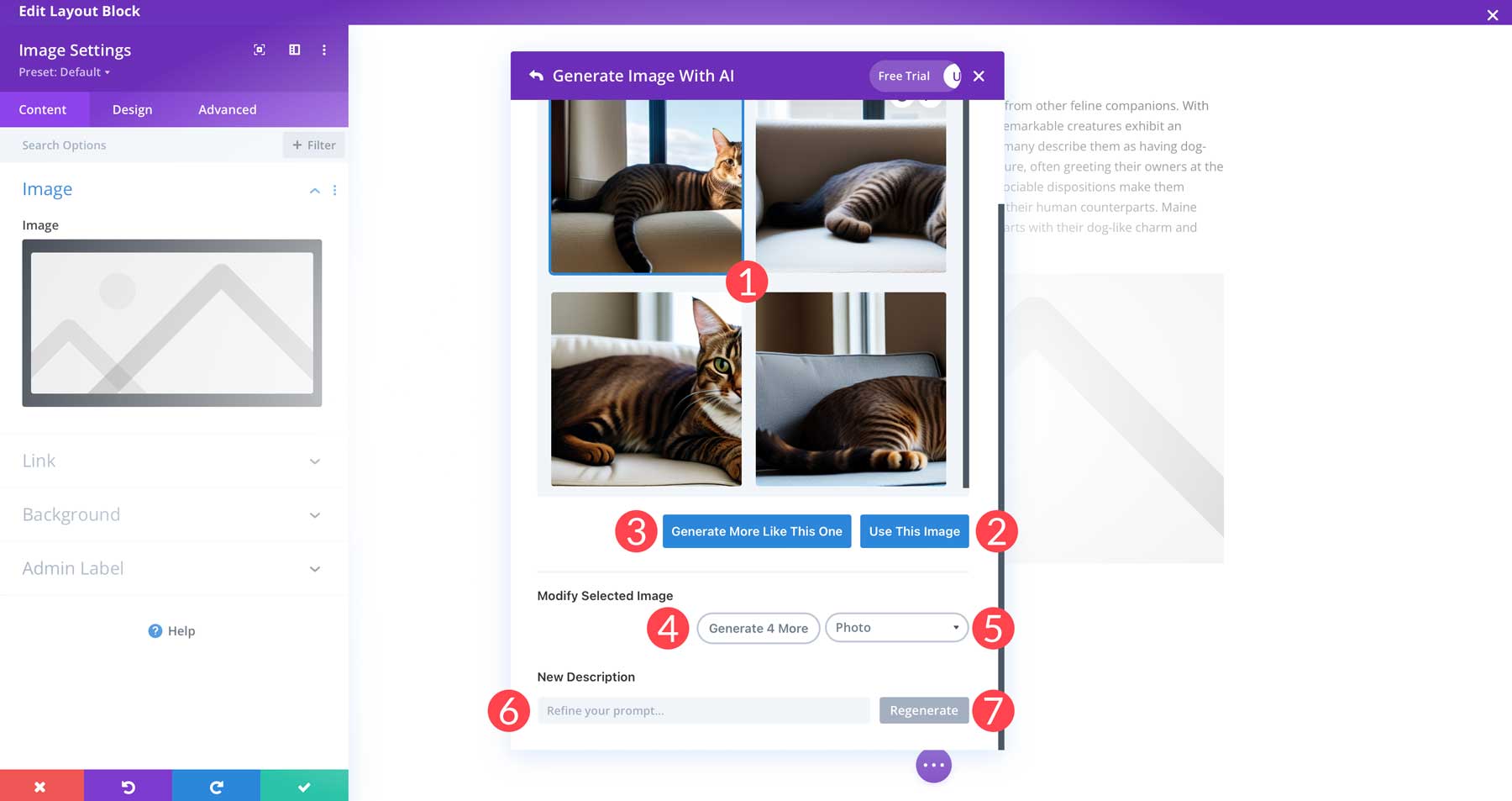
Once you have selected a photo to utilize, Divi will automatically insert it into your image module. From there, by clicking the AI icon again and choosing upscale</strong you can enlarge it to enhance its quality.
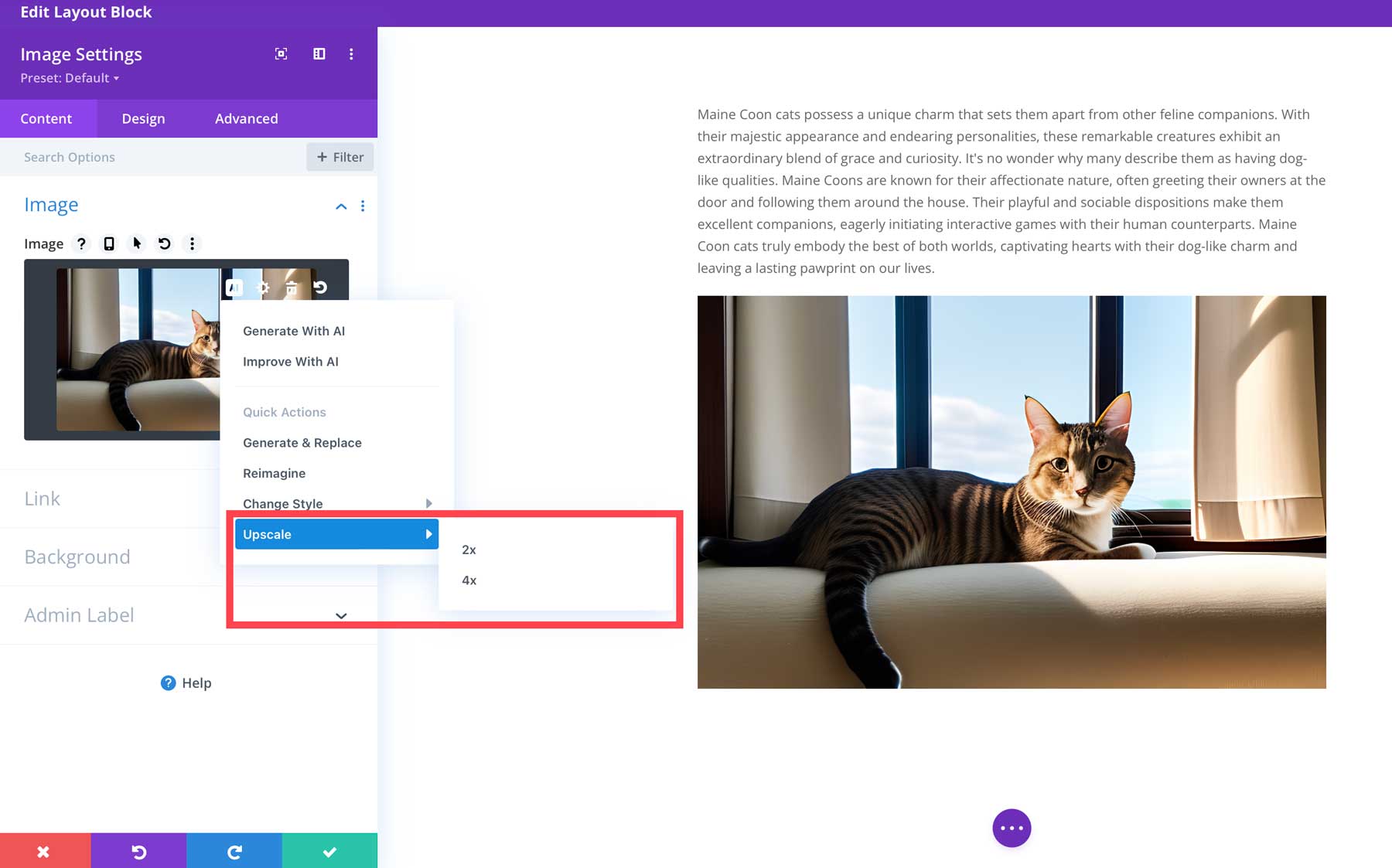
Step 5: Writing the Post Content
Now that we have created our title, opening paragraph, and prominent image, let’s go through the steps necessary to formulate the main content.
Using ChatGPT
To formulate the main body of your blog post using ChatGPT, you will repeat the steps described earlier. Return to ChatGPT and prompt it to craft the body of the post. This can be accomplished by inputting the following prompt: Based on the outline above, construct the post content except for the conclusion. Keep it within 1500 words, and maintain the same style as the opening paragraph.
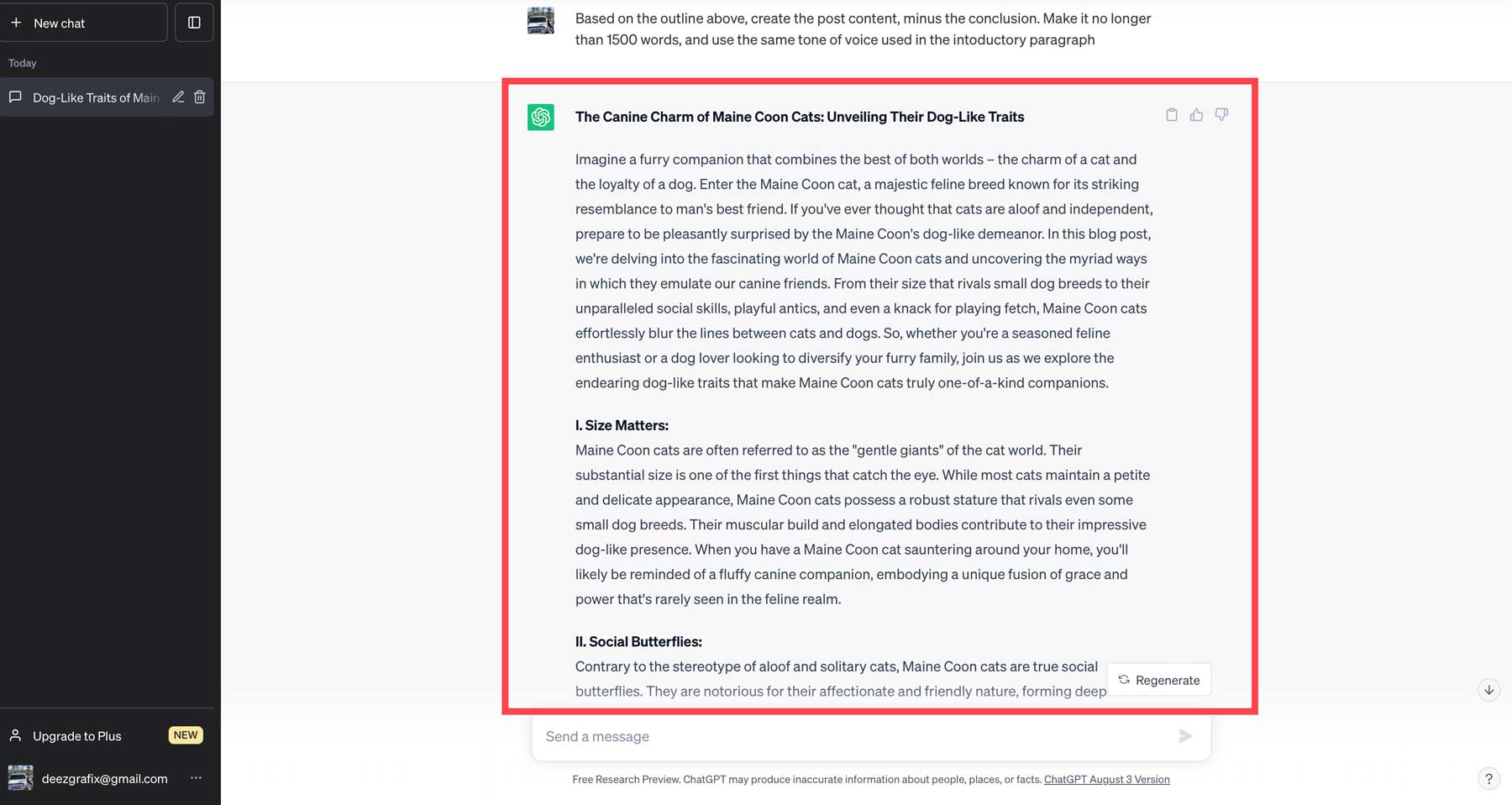
ChatGPT will proceed to craft the main content. As highlighted earlier, use this text as a reference and not simply copy-pasting it into your post. Various reasons support this approach. Firstly, ChatGPT may produce inaccurate information. Consequently, it is crucial to fact-check everything it provides. Additionally, Google is improving its capability to identify AI-generated content. Even though this technology is relatively new, over-reliance on generated content without human intervention could negatively impact your SERP rankings.
Moreover, plagiarism concerns may arise since ChatGPT was trained on data sourced directly from the internet. Lastly, generated content often lacks creativity and personality. Therefore, we advocate utilizing the output as a guide to overcome writer’s block or to stimulate creativity in writing.
Using Divi AI
Now that Divi AI has context, we can proceed in one of two ways: either use Divi AI to compose the entire post or generate a few paragraphs at a time. The decision hinges on whether you intend to create additional images. If your plan only includes a single image in your post, Divi can formulate the entire post for you. However, if you wish to include additional supporting visuals, you will need to generate a few paragraphs at a time. To generate your complete post, activate Divi AI by adding a new text module and clicking the AI icon again. Screen the dropdown menu when the dialog box appears and select blog post.
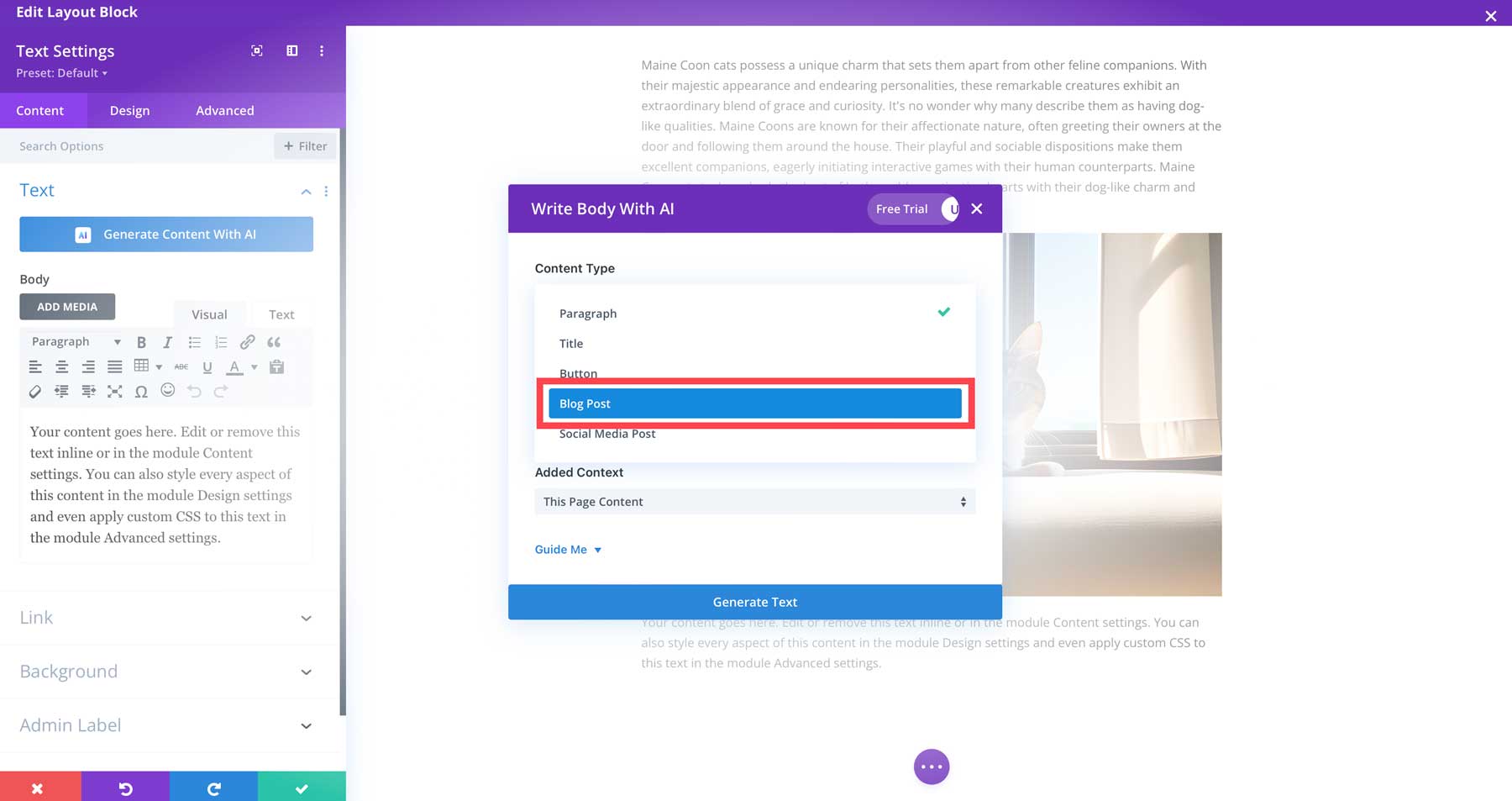
In the What are you writing about text field, return to ChatGPT to copy the blog outline we devised in step 1, then paste it into the field. Ensure to exclude the intro section.
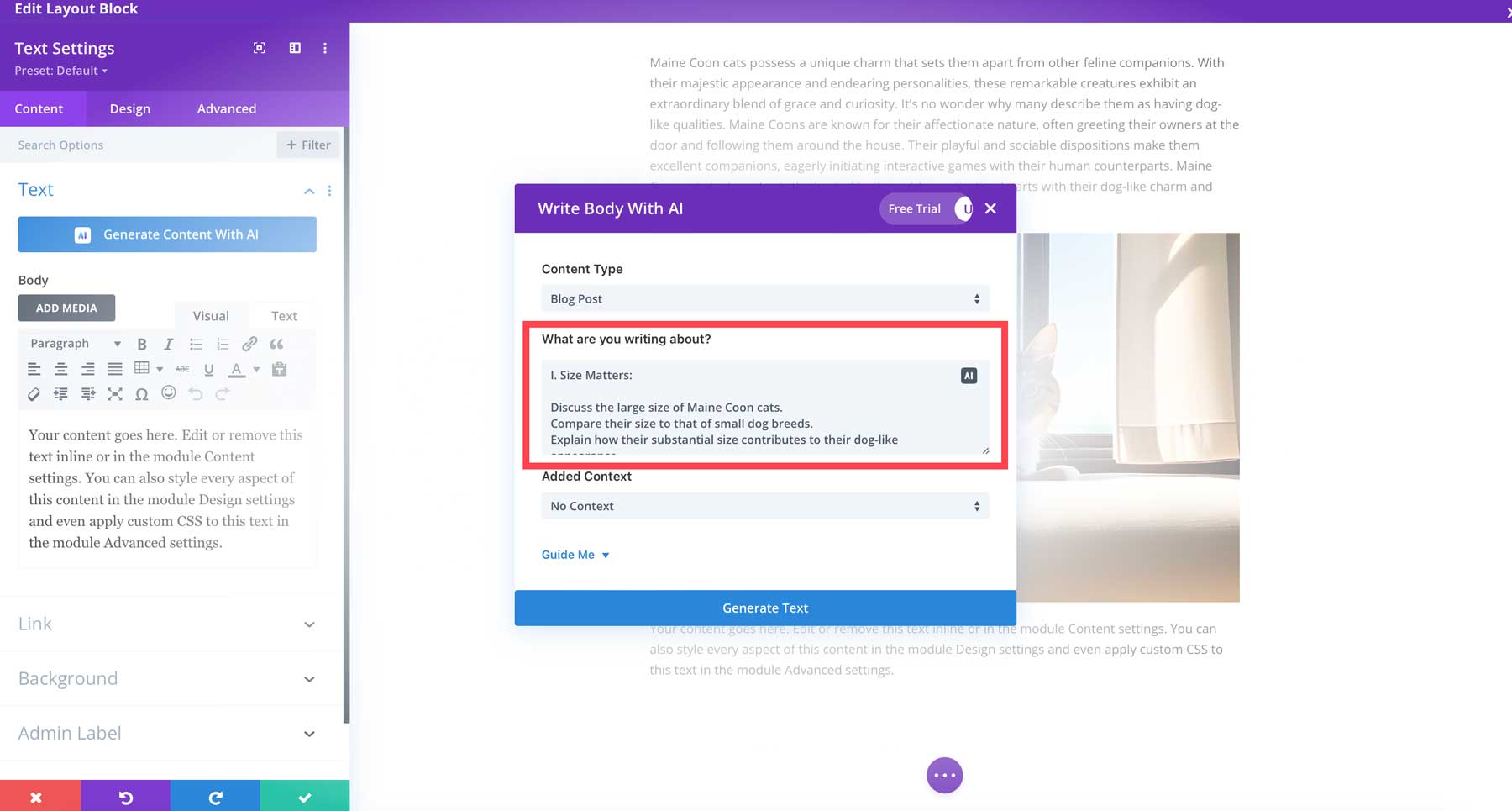
Click lead me (1) to expose the additional configurations. Make certain to incorporate your style (2), required keywords (3), specify the amount of words to produce (4), select the dialect (5), then generate your post (6).

Suggestion: When generating content with Divi AI, add titles for your crucial paragraphs. Also, use Divi AI’s word settings to keep paragraphs under 300 words. By doing this, you’ll achieve a higher SEO score with your chosen SEO plugin.
Step 6: Creating the Ending
The act of writing the finishing section is the ultimate step in fashioning your opening post. If using ChatGPT, all that is required is to deliver it a prompt to accomplish the post. For example, provide it the following: Based on the outline above, write a conclusion paragraph in the same writing style.

Compose Ending with Divi AI
To fashion our conclusion passage, we’ll adopt a slightly different methodology. In place of leaving the context empty, for this last paragraph, we’ll have Divi create a conclusion based on the content of our post. To do this, add a new text module, then fill in the following settings:
- Content type: Paragraph
- What are you writing about: Summarize the various ways in which Maine Coon cats exhibit dog-like traits.
- Added context: this page content
- Tone of voice: Creative
- Must use keywords: Maine Coon cats
- Content length: About 250 words
- Language: Language of prompt
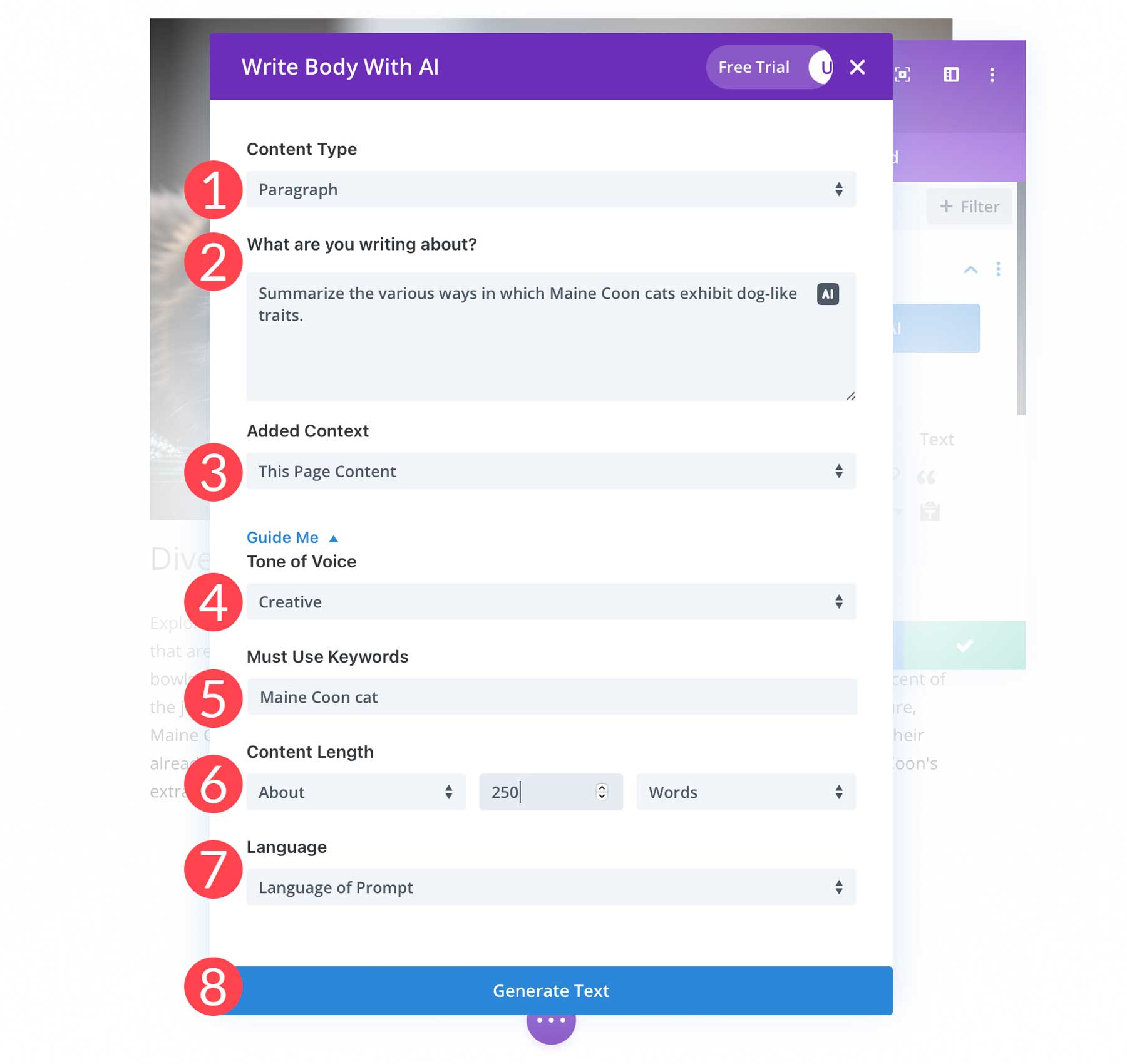
That’s it! You’ve successfully produced a well-written blog post with Divi AI.
Blog Post Images
So you can get a clearer idea of how remarkable Divi AI image creation is, we thought you might like to take a look at the images we generated for our Maine Coon cat post:
Prompt:Photo of a Maine Coon cat sitting in a window, majestic, award winning photography

image created with Divi AI
Prompt:Photo of a Maine Coon cat wearing a harness, highly detailed fur, walking on pavement, afternoon lighting

image created with Divi AI
Prompt: Photograph of a Maine Coon cat, clean sharp focus, highly detailed fur, green eyes, cinematic lighting
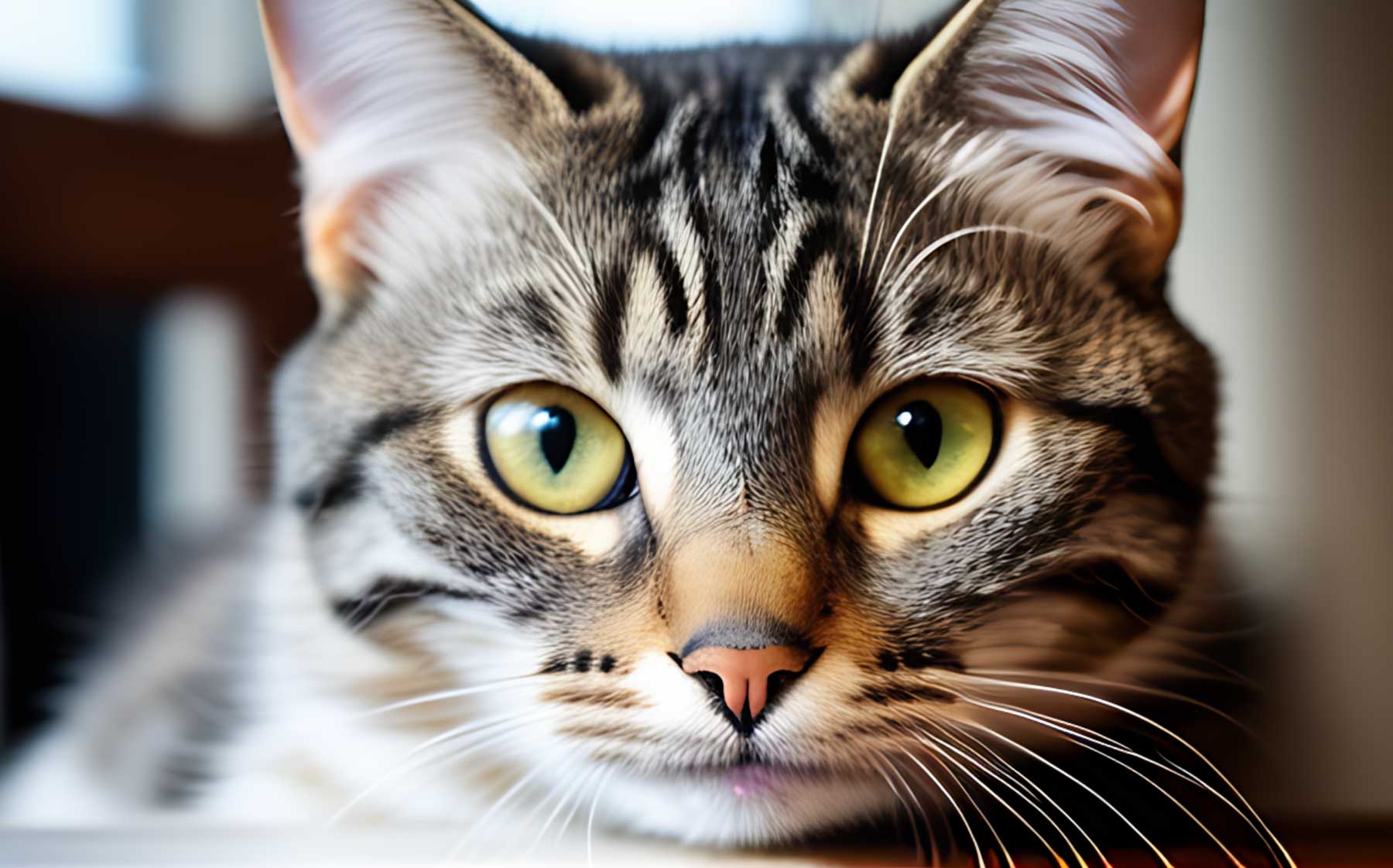
image produced with Divi AI
Prompt: A highly intricate image of a Maine Coon cat, moving through water, causing ripples, with a clean and focused view, 8k resolution

image created with Divi AI
Concluding Remarks on Composing A WordPress Blog Post Using AI
Through the utilization of generative AI, freelance professionals, and website proprietors can effortlessly draft blog entries with AI. With platforms like Divi AI and ChatGPT, what traditionally demanded a day or two (or occasionally more) now only requires a fraction of the duration. By prudently and ethically employing artificial intelligence, we can harness its creative potential, amplify productivity, and infuse enjoyment into writing!
What aspect of our innovative artificial intelligence feature excites you the most? Share your thoughts in the comments section below.


